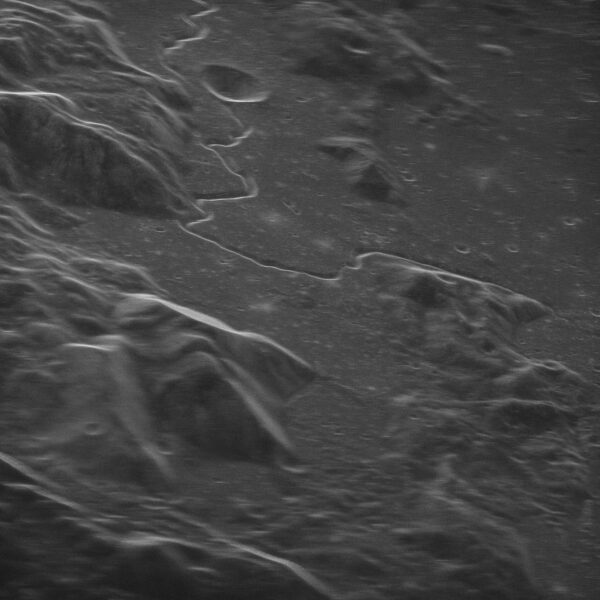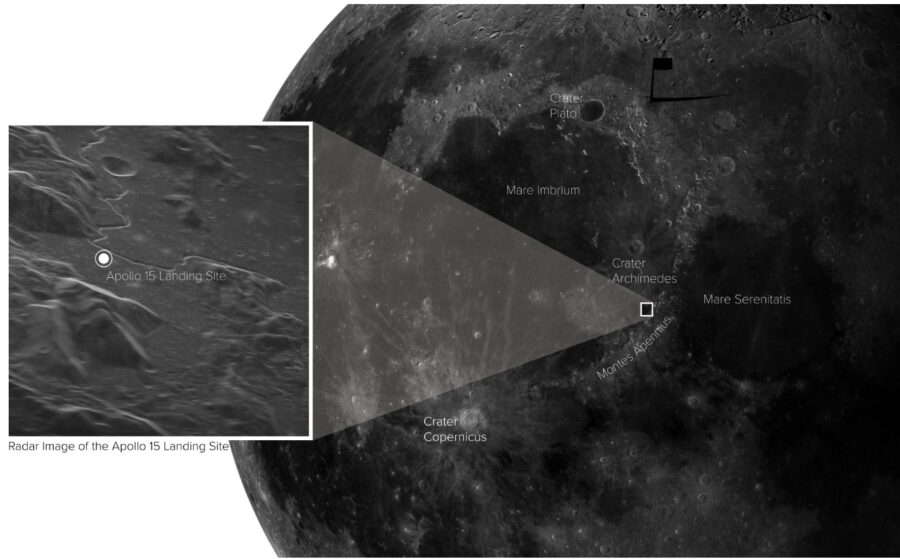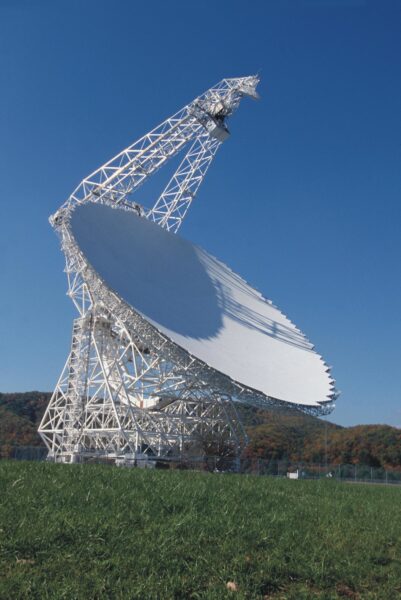A newly installed planetary radar system on the Green Bank Radio Telescope will probe the solar system in detail.

NRAO / GBO / NSF / AUI
This may look like an ordinary visible-light image . . . in reality, it’s anything but.
The image was constructed using a new 700-watt transmitter installed at the Green Bank Observatory in West Virginia, which sent the radar signal to the Moon. A network of radio telescopes caught the reflected signal to create the image of the Hadley Rille feature snaking near the Apollo 15 landing site.
The image shows features as small as five meters across; for context, the base of the descent stage — the largest piece of hardware left on the lunar surface during the Apollo missions — is just shy of five meters.

NRAO / GBO / NSF / AUI / USGS
A Next-generation Planetary Radar
The loss of the Arecibo radio telescope in Puerto Rico late last year left a gap in terms of planetary radar. The instruments suspended above Arecibo's 305-meter dish were the most powerful planetary radar system in the world. The 1-megawatt transmitter actively pinged near-Earth asteroids to paint their ghostly profiles, revealing astonishing detail such as binary systems and even tiny moonlets.

Arecibo / GBO / JPL / NASA / NSF
The new radar at Green Bank is the result of a two-year collaboration between the National Radio Astronomy Observatory (NRAO), the Green Bank Observatory, and Raytheon Intelligence & Space. Raytheon designed the powerful radio transmitter installed at Green Bank.
Green Bank transmits the signal that’s received by the NRAO's Very Long Baseline Array, a collection of 10 radio telescopes spanning the contiguous United States, Hawaii and St. Croix in the Caribbean. These individual telescopes work together via radio interferometry to achieve the resolution of a single giant radio telescope. The team hopes to share additional radar results late this summer.

VLBA / NSF
A New Road for Green Bank
With a 100-meter (328-foot) dish located in the National Radio Quiet Zone in eastern West Virginia, Green Bank Observatory hosts the largest fully steerable radio telescope in the world. The observatory began operations in 1956, and astronomers have used the radio dish to study galactic evolution, pulsars, compact radio sources and more. Closer to home, Green Bank has also been used to track spacecraft, follow comets, and measure the spin rate of solar system objects such as Mercury and Europa.
The Green Bank Telescope suffered its own collapse in 1988 before returning to full operation. In 2016, the facility separated from the NRAO due to funding issues. Green Bank and the NRAO now operate under separate contracts with the National Science Foundation, in partnership with Associated Universities Incorporated.

GBO / NSF
“This project opens a whole new range of capabilities,” says Tony Beasley (NRAO) in a recent press release. “We’ve participated before in important radar studies of the solar system, but turning the Green Bank Telescope into a steerable planetary radar transmitter will greatly expand our ability to pursue intriguing new lines of research.”
A Look Ahead
The ultimate plan is to incorporate a 500-kilowatt high-power radar to produce radar images with an unprecedented level of resolution. The Green Bank and VLBA system will be capable of imaging solar system objects out to the orbit of Neptune.
“The planned system will be a leap forward in radar science, allowing access to never-before-seen features of the solar system from right here on Earth,” says Karen O’Neil (Green Bank Observatory site director) in a recent press release.
If the amazing Apollo 15 landing site image is any indication, we can expect to see some impressively high-resolution radar in the years to come.
 17
17
Comments
Anthony Barreiro
February 2, 2021 at 3:35 pm
The image of Hadley rille is truly impressive.
If this system were used to image Neptune's moons or Kuiper belt objects, what kind of resolution would it have?
Could the Green Bank transmitter be used to send messages to potentially habitable nearby exoplanets?
You must be logged in to post a comment.
Yaron Sheffer
February 3, 2021 at 3:15 pm
Hi AB,
If we keep the angular resolution constant, then the spatial resolution goes up with distance. Thus 5 meters on the Moon would become 5 meters times how many lunar distances (LDs) there are from here to your favorite object. For example, the Sun, which is 1 AU away (400 LDs), would be resolved down to 2 km.
Of course you can point the radar at exoplanets and "zap" them 🙂 But the nearest ones have been watching our TV shows for many many years by now! Proxima has the best seat and is getting our latest shows from 2016, going into 2017.
You must be logged in to post a comment.
Anthony Barreiro
February 3, 2021 at 6:41 pm
If my rough calculation is correct, this system would have a resolution of about 12 km at Neptune's distance. Voyager 2 took pictures of Triton with a resolution of 600 meters. That was just a fly-by, presumably an orbiter would get much closer, and camera technology has gotten better in the past 50 years. So this radar system won't be anywhere near as good as spacecraft with cameras, but I suppose more continuous Earth-based observations could complement what spacecraft see.
You must be logged in to post a comment.
Don-Kerouac
February 5, 2021 at 6:23 pm
RF engineering is my specialty. Theoretically yes, it could send a high pulsed radar to a nearby stellar system. The Green Bank is large enough. The receive station at the far end would have to be a comparably large installation. It would have to know when an where to collect data. Then they could scratch their heads (or whatever) and wonder just what it was they were receiving.
Of course, we have tried to do just that with smaller installations such as SETI. Also, we have sent out deliberate pulses and even listened from Areicbo and other instruments.
Except for SETI, VERY little time has been allocated to such endeavors. As you certainly know, telescope (optical, radio, radar, gravity) time is expensive, precious and in big demand.
Assuming any nearby exoplanets are Earth like, there is the time line variable from the genesis of simple life to technological life.
Sorry about the long winded reply. I suspect you are likely cognizant of much of this.
You must be logged in to post a comment.
Anthony Barreiro
February 7, 2021 at 7:43 pm
Thank you for the detailed answer! I appreciate hearing from somebody who understands not just the theory, but also the practicalities. Now I'm imagining the alien version of the movie "Contact" with the aliens scratching their heads or whatever.
You must be logged in to post a comment.
jacobus-nl
February 3, 2021 at 5:44 am
Impressive indeed!
How powerfull was the transmitted ‘ping’ in this test? The article mentions Arecibo’s 1 megaWatt and Green Bank’s future 500 kiloWatt transmitters, but no mention of the power of the transmitter currently installed at Green Bank (no mention in the press release either).
You must be logged in to post a comment.
David DickinsonPost Author
February 3, 2021 at 7:47 am
Hi Jacobus,
Thanks... I noticed that, too. I 'ping'd' the NRAO for a comparison of the current system with Arecibo's planetary radar, with no reply. The best I found in research was Arecibo vs. what the current system at GBO is expected to attain with full operability.
You must be logged in to post a comment.
Moose T
February 5, 2021 at 6:35 pm
On the GBT website I found this interesting sentence: "The GBT is also readily reconfigured with new and experimental hardware, adopting the best technology for any scientific pursuit." It doesn't give us any new information about the strength of the signal used to make this image, however it gives the sense that it is relatively rapidly reconfigurable. So instead of a decade to implement this upgrade it may only be a few years.
I'm curious about what this can discover about the population of various Lagrange points around the solar system.
You must be logged in to post a comment.
Rod
February 3, 2021 at 12:45 pm
"The image shows features as small as five meters across..." My observation. Impressive. The Moon 385,000 km from Earth, a telescope using optical light with eyepiece and focal length resolving 1", can see an area ~ 1.867 km in diameter.
You must be logged in to post a comment.
Yaron Sheffer
February 3, 2021 at 3:30 pm
We optical astronomesrs are duly impressed by those super-resolutions from our radio colleagues. But remeber this: our telescopes are more compact. The VLBA that was used to generate the 5-meter sharpness Moon image is a radio array which is 2.5 times larger than the Moon itself...
You must be logged in to post a comment.
Anthony Barreiro
February 4, 2021 at 4:25 pm
Are you having aperture envy? Imagine the environmental impact report for a piece of glass this big! 😉
You must be logged in to post a comment.
Yaron Sheffer
February 7, 2021 at 6:20 pm
But of course! With a glass that big you could resolve the disks of red supergiants in the Virgo cluster, or resolve exocontinents on exoplanets 1000 light years away, or resolve our own Kuiper belt objects down to 1 meter...
You must be logged in to post a comment.
robin_astro
February 7, 2021 at 9:37 am
The advantage of radar though is the very high precision of distance measurement which reveals topology and movement. Also the reflectivity at different wavelengths gives additional information about the composition of the surface and potentially just below it.
You must be logged in to post a comment.
Andrew James
February 5, 2021 at 5:29 pm
Is it true that the clandestine motive for this is to monitor future mining operations on the Moon? This to get around the space treaties and those who wish to exploit loopholes. It breaks no laws on Earth. Issues around this are like this page. https://phys.org/news/2020-04-trump-moon-asteroids.html
You must be logged in to post a comment.
Andrew James
February 5, 2021 at 6:09 pm
Looking at the Lunar Reconnaissance Orbiter (LRO) data is infinitely better than this e.g. This NASA 750-metre wide image of an unnamed crater is near the Reiner Gamma Swirl in Oceanus Procellarum.at https://www.nasa.gov/images/content/581579main_081211a.jpg Again, there seems no real advantage looking at the Moon this way, but it is better and cheaper than sending spacecraft there!
You must be logged in to post a comment.
Andrew James
February 5, 2021 at 6:13 pm
A NASA LRO image for direct comparison of this region is here. https://www.nasa.gov/mission_pages/LRO/multimedia/lroimages/lroc-20110830-apollo.html [2nd image.]
You must be logged in to post a comment.
Andrew James
February 5, 2021 at 6:15 pm
...or here "Apollo 15: Interplanetary Mountaineers" https://www.nasa.gov/content/goddard/apollo-15-original-interplanetary-mountaineers
You must be logged in to post a comment.
You must be logged in to post a comment.